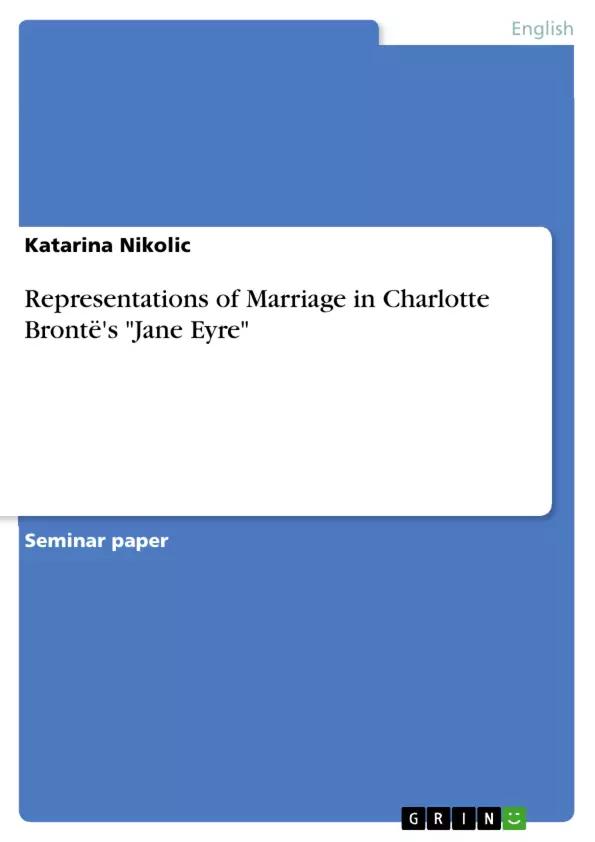How does Charlotte Brontë negotiate the Victorian marriage plot in her novel "Jane Eyre"?
In the first part of this term paper, the ideology of separate gender spheres and how it reaffirmed the Victorian marriage (plot) is presented. A reference to the following questions is made: If and how were love and marriage connected with each other? What were the reasons for marriage in Victorian times? How did a marriage look like?
Furthermore, the three marriage plots in Jane Eyre are described: the marriage of Rochester and Jane, the "hidden" marriage of Rochester and Bertha und the unfulfilled marriage of St. John and Jane. The paper focusses on how they differ from each other and to what extent they correspond to marriage in the Victorian era as described in the first part. In addition to that the aspect of Jane Eyre’s social status and gender is depicted and what it meant to be an unmarried woman in Victorian times, as portrayed in the novel.
Inhaltsverzeichnis (Table of Contents)
- Introduction
- Marriage in the Victorian era
- Victorian gender ideals and the ideology of separate spheres
- Marriage plot as a literary pattern in Victorian literature
- Negotiations of love and marriage in Charlotte Brontë's Jane Eyre
- The “hidden” marriage of Rochester and Bertha
- The relationship between Rochester and Jane
- The unfulfilled marriage of St. John and Jane
- Unmarried women: the governess as protagonist
- Conclusion
Zielsetzung und Themenschwerpunkte (Objectives and Key Themes)
This term paper aims to explore the concept of love and marriage in the Victorian era, specifically focusing on Charlotte Brontë's novel Jane Eyre. It examines the influence of Victorian gender ideals and the ideology of separate spheres on marriage plots in literature. By analyzing the various marriage relationships in Jane Eyre, the paper seeks to understand how Brontë negotiates the traditional marriage plot within the context of Victorian society.
- Victorian gender ideals and the ideology of separate spheres
- The marriage plot as a literary pattern in Victorian literature
- Negotiations of love and marriage in Jane Eyre
- The role of the governess as a female protagonist
- The impact of social class on marriage expectations
Zusammenfassung der Kapitel (Chapter Summaries)
The first chapter introduces the context of the Victorian era, explaining the dominant model of separate spheres and its influence on marriage expectations. It explores how Victorian gender ideals shaped the roles of men and women in society, particularly within the domestic sphere.
The second chapter delves into the concept of the marriage plot as a literary pattern in Victorian literature. It discusses the various types of marriage plots that emerged during this period and provides examples of their use in well-known Victorian novels.
The third chapter focuses on the three marriage plots in Jane Eyre, analyzing how they negotiate love and marriage in different ways. It examines the complexities of the relationships between Rochester and Jane, Rochester and Bertha, and St. John and Jane.
The fourth chapter explores the role of the governess as a female protagonist in Jane Eyre. It analyzes Jane's social standing and the challenges she faces as an unmarried woman in Victorian society.
Schlüsselwörter (Keywords)
This term paper delves into the key themes of Victorian gender ideals, the ideology of separate spheres, the marriage plot in Victorian literature, love and marriage, and the social standing of women in Victorian society. It uses Charlotte Brontë's Jane Eyre as a case study to examine these concepts and how they are negotiated within the context of the novel.
- Citar trabajo
- Katarina Nikolic (Autor), 2022, Representations of Marriage in Charlotte Brontë's "Jane Eyre", Múnich, GRIN Verlag, https://www.grin.com/document/1463852



